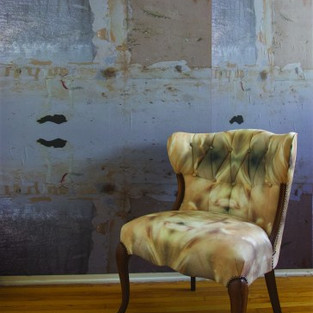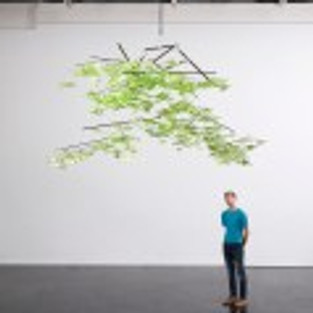
Blind Courier, Brand Library; Photo courtesy of Lauren Kasmer
The Poetics of Place
Brand Library, Glendale through August 23
Written by Constance Mallinson Binary narratives are often used when trying to characterize the modern city: nature v. culture, extreme wealth v. dire poverty, planning v. unbridled, speculative growth, migrations and homelessness v. “stable populations”, racism v. inclusivity, typically define the global urban experience. Los Angeles which is the main focus of this exhibition at the Brand Library has elicited a rich body of critical literature by which to explore these dichotomies, most notably Mike Davis’s City of Quartz and the Ecology of Fear. Davis reveals that the place of eternal sunshine, dreams and opportunities also exists aside its evil twin– the dark underbelly of utopia with its pending nightmares of eco and natural disaster, rampant and uncontrolled consumption and development, phlegmatic traffic, and seemingly incurable social problems While artists Robert Aull, Hilary Baker, Lauren Kasmer, Sharon Levy, Diane Meyer, Minoru Ohira, Osceola Refetoff, Samuel Scharf, and Andrew West in Blind Courier variously touch on these issues, they maintain a more nuanced perspective, alerting us to the contradictions, complexities, instabilities, disparities, and competing interests that comprise contemporary urbanism. Without losing criticality, they coalesce around the notion that consciousness of form foments content, their diverse artworks prioritizing meticulous craft, material beauty and wonder over propagandizing.
Curated by Hilary Baker and Lauren Kasmer the show takes its rather enigmatic title from cultural critic Norman Klein’s The History of Forgetting in which the author imagines Walter Benjamin ruminating as a flaneur in Los Angeles, writing “The city is a blind courier. It brings nothing. It takes nothing.” If there’s any parallel with Walter Benjamin’s theories, however, it is perhaps in the imaginative examination of everyday common objects, locations, and nature that are largely rendered invisible by powerful economic forces. Official myths and histories are based on the perpetuation of industrial/technological capitalism so quick turnover and disposable models of consumption as well as cultural ADHD are essential. Benjamin conversely argued for a perceptual experience of images, places, and artifacts as a means to reading a city’s truths about social formations and spatial orderings, avoiding totalizing frameworks and allowing for mutable, alternative meanings and references to emerge. In her short but very insightful catalog essay, artist and writer Julia Couzens acknowledges how our times concede to Benjamin’s desire for a “disintegration of consensus and shared views”; she sees the artworks here as “existential speculations grounded in experience.”
The whiff of decay, dystopia and ruination is quite pronounced in Robert Aull’s exquisite fantastical small scale models depicting rusted industrial structures. In mood and fastidious sculptural approach they resemble Michael McMillan’s evocations of L.A.’s attachment to its cinematic history but Aull brings into play his childhood memories of long disappeared oil derricks, refineries, and urban infrastructure dotting Baldwin Hills and L.A. where he grew up. Some of his constructions are adhered to stones to perhaps symbolize the once abundant geology from which the oil was extracted. These miniaturizations of mighty machinery are equally ironic celebrations of the country’s past industrial greatness as well as rebukes to American notions of progress and its MAGA yearnings.

Robert Aull, Blind Courier, Brand Library; Photo courtesy of Lauren Kasmer
Similarly, Hilary Baker’s paintings of native animals and water towers in vanished iconic Los Angeles locations come with a warning label. Within these backdrops of now forgotten historical landscapes, Baker foregrounds what she describes as feral predators– a mountain lion, a rattlesnake, or a pair of deer- who, displaced from their natural habitats, stare plaintively at the viewer. Although native Angelino Baker leans toward the clean, graphic approach of animation long produced in Los Angeles studios, these depictions do not sentimentalize or humorously humanize. Rather they confront us head on with the collision of nature and a rapidly changing built environment. Echoing wildlife’s predicament, the lost water towers, flattened into geometric shapes with her trademark stylized wood grain are memento mori to our architectural treasures and landmarks. Upending traditional distinctions between rural and urban, Baker invites a wholesale revision of ideas of preservation that envision co-existence with nature and history—even ruins.
Like Baker, Andrew West captures the convergence of the natural and the built environment. The tensions for West are expressed in a group of muscular, thickly textured abstract paintings that synthesize architectural elements and organic forms. The colors on no longer extant Los Angeles architecture and the Amsterdam residential buildings where he previously lived are physically—almost sculpturally—memorialized and embodied in paint. These impastoed swathes wrestle in a Gordian knot with wide strips of paint that seem to reference fragments of city features like parks or asphalt. As seen throughout the exhibition, structure vies with chaos, memory with forgetting, to portray the city as a bundle of conflicting desires and needs.
A lovely reminder that contact with nature is available in the city is Sharon Levy’s “Canopy”, an overhead mobile constructed of wooden dowels and handmade translucent green paper leaves. Gently swaying in the gallery’s air currents it mesmerizes and calms, promoting meditation on the importance of nature’s beauty and air cleansing powers. While not overtly stating the tensions between the green world and the one humans have wrought, Levy’s reverence for nature’s balm on a stressed humanity brings to mind eco-writer Gretel Ehrlich’s statement that “We humans do not save beauty; rather beauty saves us.” Like Baker Levy implies city spaces need to be mindful of plant and animal communities. In light of climate change, this attitude might be bound to species survival.
The fires of 2018 in the Los Angeles (and northern California) environs were of course a terrifying laboratory of how quickly civilization can be consumed. Lauren Kasmer’s “Flourish From Fire” is a mixed media installation mimicking a domestic setting including a sofa, armchair, rugs, artwork, and wall paper imprinted with imagery from her fire ravaged home. A paeon to ideas of “creative destruction” this powerful work evidences that ruination can be fecund, evincing the potentialities of decay and loss. Kasmer interrogates and confounds how we see the normal ordering of destruction, as the charred remains are perhaps in our minds inappropriately reborn into the realm of aesthetics. In addition to metaphors of rejuvenation, rebirth and transformation, Kasmer’s installation serves as a Benjamin-esque critique of commodity capitalism’s imperative to eradicate the outdated and ruined and install the brand new. Sitting on her sofa surrounded by ravaged and ashen motifs, watching her video comparing her European heritage and Native American creation stories, we are jarred from our comfort and confronted with the idea that we cannot and should not erase the memory of conflagrations.
Los Angeles artist Diane Meyer’s “needlepoint samplers meet digital photography” focus not on Los Angeles but rather on the 100 mile length of the defunct Berlin Wall that once divided East and West Germany but in their deconstructive proclivities extend these ideas abroad. Her intricate, laboriously hand embroidered photographs of these sites are a way of contesting official history and reinterpreting the finality of momentous events. In opposition to the impersonal “objective” photograph, Meyer introduces slow feminine handcraft with its tactility, sensation, and textures as she mimics the digital pixels through her luminous stitches. Like Kasmer, Meyer’s work unsettles and transforms normative views, challenging the veracity of the photograph in favor of improvisation and embellishment. Both artists create beautiful alternatives to historical erasure in powerful metaphors of remembering and regeneration.
The photograph as factual evidence is also undermined by Osceola Refetoff’s pinhole camera shots of Los Angeles’s street scenes and inhabitants. The pinhole technique renders much of the imagery as abstract and vaguely recognizable, dreamlike, mysterious and often ghostly. Without specificity, one is immersed in an impressionistic blur of the city, as if rushing by in a car or striding past quickly. Refetoff revels in one of the paradoxes of living in Los Angeles or any large city. By abstracting/distilling the experience of the city into almost pure color and form Refetoff celebrates the vibrancy of his environment as a non-stop parade of visual and sensory treats. While difficult to see this appreciation as critical of visual entertainment, the artist’s emphasis on aesthetics, motion and frequently mysterious images begs comparison with Hollywood’s cinematic history of noir, horror and manufactured beauty.
Similarly, Samuel Scharf ‘s construction of industrial looking solar lights contained in a circular corral and mounted on a photographic tripod evokes L.A.’s historical connection to the film industry. The solar cells charge by day then apparently light up at night when the gallery in closed, a playful updating of L.A. as the new artistic capital displacing Benjamin’s Paris as the City of Light. Like a large klieg light from a movie set, or alternatively an artificial sun suggested by the yellow frames surrounding the lights, the sculpture is a reminder of both the sun and natural surroundings that sustained the industry, and in its stored energy that makes nightlife possible, a metaphor for the projectors and the “dream factory” that bring life forth from the darkness of movie theaters into solitary psyches. A separate large scale wood sculpture consists of a bending or contorted “X” shape that Scharf sees as symbolic of both change, flexibility, and origins.
Materially driven, master of accreted sculptural form and multiplying references, Minoru Ohira describes his approach as an amalgamation of archeology, Japanese culture and architecture, western design and natural materials. His “Hamburger City” constructed of countless small wedges of wood mounted on a disk simultaneously conjures a sprawling teeming cityscape form an airplane window and well, a monstrous beef patty. Deceptively simple yet exceedingly complex, Ohira’s piece inextricably connects exploding cities and overcrowded planets to the correlating –and competitive–need for food. Moreover, the individual elements are subsumed by but also contribute to the whole. A profounder meditation on the dilemmas of inhabiting the earth or a colossal metropolis today would be hard to find.
The exhibition will perhaps justifiably be called out for its omission of expressions of the city’s Latino and African American perspectives but it’s important to note that many of the city’s cultural institutions such as the Hammer have admirably dealt with the diverse identity politics of Los Angeles. And it should be noted that the Brand has recently offered inspiring, inclusive exhibitions such as Valley Girls and The Art of Politics in L.A.
Blind Courier is anything but blind as it grapples with a multifaceted urbanism– from its lurking post-industrial dystopia to its interfacings with the non-human world. No single exhibition can suffice as the urban landscape has infinite stories to tell and endless identities to explore. The artists of this exhibition, like Walter Benjamin whose writings helped inspire the curators, refuse simplistic readings and never lose sight of what the city can and will reveal.
Brand Library 1601 W. Mountain Street, Glendale, 91201
#losangeles #california #losangelesartist #art #painting #shoeboxpr #MinoruOhira #laverne #losangelesart #contemporaryart #southerncalifornia #ConstanceMallinson #abstract #collage #HilaryBaker #brandlibrary #artgallery #artinterview #gallery #museum #artandcake #artexhibition #installation #glendale #fineart #artist #soloshow #mixedmedia #arts #artreview #DianeMeyer #artmagazine #AndrewWest #ArtandCulture #exhibition #RobertAull #LaurenKasmer #SamuelScharf #exhibit #osceolarefetoff #SharonLevy
































